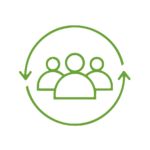Sick Leave: Benefits, Pay and a Path to Equity
Employee Benefits
Sick Leave: Benefits, Pay and a Path to Equity
In the past five years, the number of states mandating paid sick leave has increased significantly. As of October 2022, 17 states (plus the District of Columbia and Puerto Rico) and several local municipalities have passed and enacted paid sick leave laws. Despite this expansion of paid sick leave mandates, access to paid sick leave is still limited. Although some employers may provide sick leave voluntarily, policies may not always include low-income and part-time employees.1
Given the global and national workforce trends and challenges following the pandemic, employers cannot afford to ignore the needs of employees. Following the COVID-19 pandemic, there has been a national employment shift where employees continue to voluntarily resign from their jobs, which has been identified as “The Great Resignation.” The Great Resignation compelled many employers to adapt quickly to address high resignation rates by offering higher pay. Access to paid sick leave can also help both attract and retain employees who might be considering a change in employer. Beyond the optics of paid sick leave, in terms of the employee value proposition, access to paid sick leave is a critical aspect that must be addressed in order to close the gaps in equity of pay and workforce inclusion.
A Competitive Landscape for Labor
In the last two years, the labor market has seen high rates of voluntary turnover, resulting in what many are calling ‘The Great Resignation.’ In 2021, voluntary resignations were the highest on record, with over 47 million voluntary resignations, according to the U.S. Bureau of Labor Statistics.2
Upon closer examination, employees are not necessarily leaving for better opportunities, according to a Pew Research Center survey conducted in February, 2022. Of those who resigned, low pay and insufficient benefits were cited among the top reasons for employees’ resignation. Some larger employers are quickly adapting to the labor market and making changes to their recruitment and retention strategies. Namely, Costco and Starbucks have announced a minimum starting wage of $17, and Target has raised its starting pay to $24.3,4,5 Wage increases have not been isolated to large employers, with employers across all industries making changes to their minimum starting wages. In a report by the ADP Research Institute, increases in wages for both employees who remained at their current employer and for those who changed employers reached record highs, with increases of 5.9% and 8%, respectively.6y
So, how does paid sick leave apply to the conversation about employee wages?
Paid sick leave resides at the intersection of pay and benefits as a form of income replacement. Paid sick leave directly compensates employees for absences related to their own illness or short-term medical needs, to care for family members, or for any of the commonly covered absence reasons under a sick policy, such as preventive care, diagnostic care, school and/or daycare closures. In contrast, lack of access to paid sick leave means employees must take a sickness related absence as unpaid, if at all. Not to mention, there is a heightened risk of contagious presenteeism. Contagious presenteeism occurs when sick employees still show up to work, either because they do not have paid sick days or do not have enough and thus are compelled to “save” their days for a potential future emergency. When sick employees show up to work, influenza-like illnesses are more likely to spread. In a study by Cornell University researchers, when employees have access to paid sick leave, contagious presenteeism goes down and the spread of illness is reduced as well.7
1 Elise Gould, “Over 60% of low-wage workers still don’t have access to paid sick days on the job”. Economic Policy Institute, Working Economics Blog, September 23, 2022. EPI.org.
2 Jennifer Liu, “Roughly 47 million people quit their jobs last year: ‘All of this is uncharted territory”, February 1, 2022, CNBC.com.
3 Nathaniel Meyersohn, “Costco raised its minimum wage to $17 an hour”, CNN Business, October 27, 2021. https://www.cnn.com/2021/10/27/business/costco-minimum-wage/index.html
4 Kelly Tyko, “Starbucks to raise average pay up to $17 an hour as it faces a labor shortage”, USA Today, October 27, 2021. https://www.usatoday.com/story/money/food/2021/10/27/starbucks-pay-raise-hourly-wageincrease-2022/8567718002/
5 Rina Torchinky, “Target is raising its minimum wage to as much as $24 an hour”, NPR Business. https://www.npr.org/2022/03/01/1083720431/target-minimum-wage
6 “Workforce Vitality Report,” ADP Research Institute, December 2021. https://workforcereport.adp.com/
7 Stefan Pichler, Nicolas Ziebarth, and Katherine Wen, “Positive Health Externalities of Mandating Paid Sick Leave”, February 2020.

